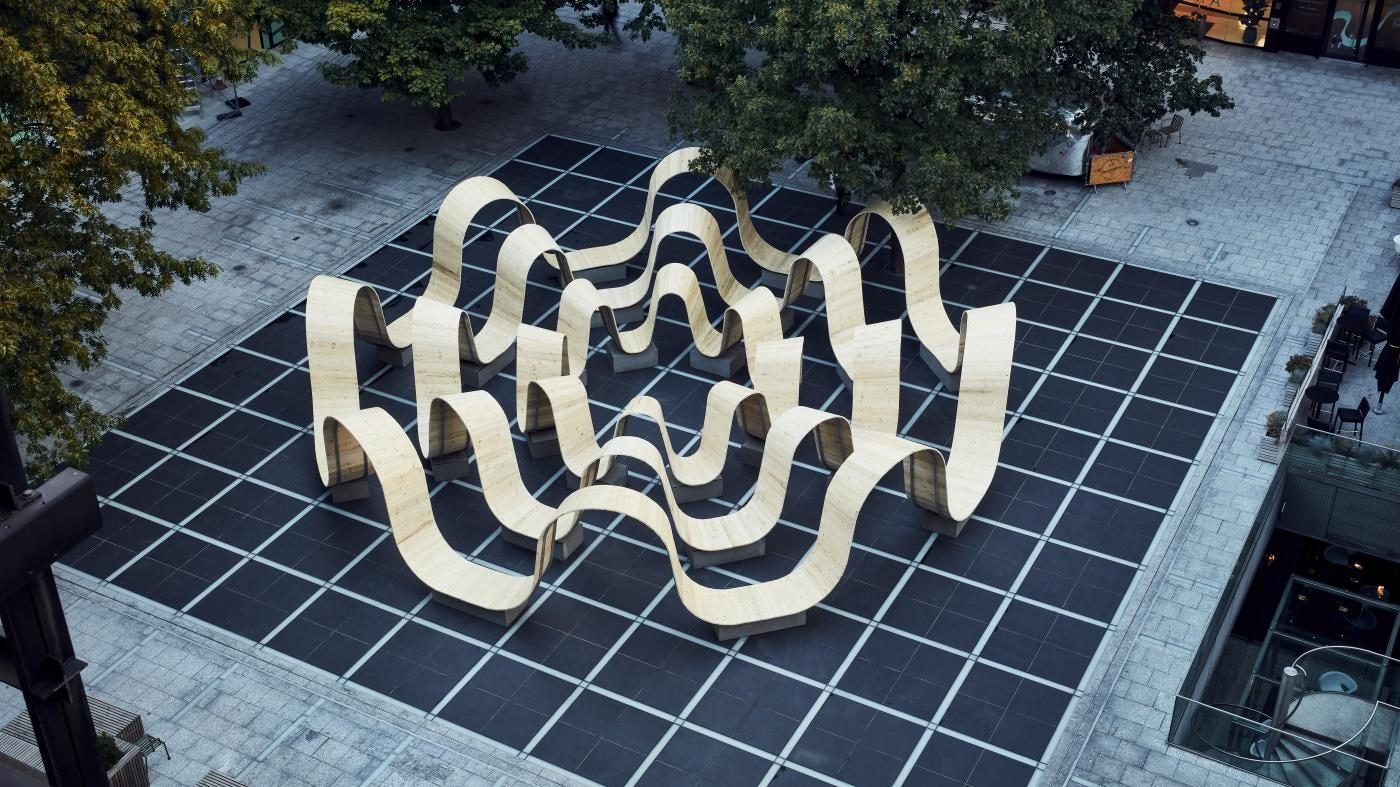Behold, London’s most thrilling public bench
London has many great spots to sit but one of the more impressive new ones may be a communal bench in the fintech enclave of Broadgate. Featured as the marquee installation of this year’s London Design Festival, “Please Be Seated” is a spectacular undulating wood sculpture. It is designed to work with the foot traffic in the office plaza.


London has many great spots to sit but one of the more impressive new ones may be a communal bench in the fintech enclave of Broadgate. Featured as the marquee installation of this year’s London Design Festival, “Please Be Seated” is a spectacular undulating wood sculpture. It is designed to work with the foot traffic in the office plaza.
“Every single aspect of this is tailored to its environment as well as the function it serves,” explained Paul Cocksedge, who designed the bench. “The curves raise up to create backrests and places to sit, [and functions] as a space for people to walk under, or pause and find some shade,” he said.
The engineering of the bench is particularly noteworthy. Cocksedge worked with the Essex-based flooring company White & White to recycle wood planks and steel poles from scaffolding used at construction sites. They invented a technique to transform the salvaged material into the smooth, seamless ribbons of the sculpture. Engineers from ARUP, the engineering and design company, made sure the wavy bench was stable.
“The creative installations provide an environment where artists, designer and engineers can come together,” says Christian Dercks, structural engineering lead. “The use of reclaimed scaffolding planks in ‘Please be Seated’ explores the reuse and repurposing of construction waste,” he points out.

I visited Cocksedge’s creation early one morning and witnessed the seamless choreography of its wavy form and the office workers who crisscrossed through Finsbury Avenue Square. With the sun bright on a rare cloudless autumn day, the scene looked so perfect that any snapshot might be construed as a computer-generated rendering. In the afternoon, one of London’s 300 licensed buskers stood beneath an arch of the sculpture, as if to serenade office workers ending the day’s toil. The bench had become the locus of a kind of unhurried urban idyll.
“Please Be Seated” recalls the communal aspect of Cocksedge’s 2015 work, “Living Staircase.” The 41 feet high functional sculpture in the atrium of the Ampersand Project building in London’s Soho district was equipped with an indoor garden, reading nooks and places for conversation.
But Cocksedge’s new creation, which will be dismantled and recycled after Oct. 11, speaks to London’s devotion to public benches. Every year, designers unveil prototypes that explode our notions about a bench’s essential qualities. A bench need not be just a boring plank on legs. Among the winning proposals in recent years: an AR-augmented bench that doubles as a sundial; an audaciously large sculpture of a coiled whippet (called “Whippet Good”) that cocoons the sitter, and a model made of 45,000 one-pence coins. Both the London Festival of Architecture and the London Design Festival encourage wild experimentation.
Londoners have seen enough bench prototypes over the years to make them adept critics of urban furniture. In 2012, many were up in arms about new concrete, graffiti-proof benches fashioned”to resist criminal and antisocial behavior.” The Camden Bench, named for the northwest London neighborhood that commissioned them, is purposely made to be uncomfortable. This is to dissuade homeless people from sleeping on it, and to prevent skateboarders from using it as a ramp.
The city’s residents are also quick to call out forms of hostile architecture in the wild, such as metal spikes and teen-repellent speakers. Last month, students from the London School of Economics castigated the so-called “anti-homeless” benches outside the campus library. The petition, that so far has garnered over 66,000 signatures. demands that the university remove the “heartless barriers” so people can use them to rest.
In a heartfelt ode to the city’s public benches, the Financial Times’ architecture critic Edwin Heathcote suggested that defending the right to recline is inherent to the British mindset. “The bench suggests the city is a place in which we can belong, without having to consume, that it is not the alienating metropolis of myth but a place capable of welcome and generosity,” he wrote. “The bench and, perhaps in particular, the park bench, has become the symbol of the democratic city—of free, accessible and equitable public space provided by the city for its citizens.”